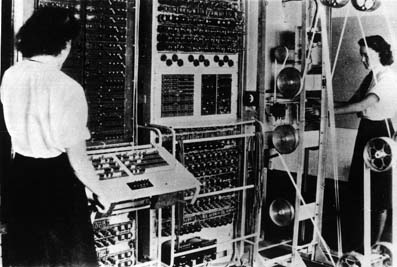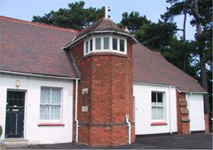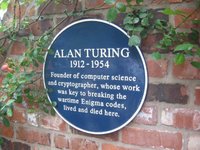Seeing History
Alan Turing
Turing (1912-1954) was one of the most original mathematical minds of the 20th century. Not being classically inclined, he failed to win a scholarship at his "public school" (this is the British term for "private school"), and went to King's College instead, where he graduated with honors in 1934. He became a Fellow of King's in 1935. His profoundly important paper "On Computable Numbers" (1936) is regarded as a keystone of the thinking that led to the computer. Turing got his PhD from Princeton in 1938. In the fall of that year he was drawn into the what was already shaping up as World War Two.
Britain declared war on Germany on 3 September 1939. On 4 September, Turing reported to Bletchley Park, the secret center of the British intelligence effort. He was first housed in an apartment in the mansion's former stable, and later put in charge of Hut 8, where work on German naval codes was concentrated. Turing quickly mapped out what would be required to consider and reject impossible settings for the German "Enigma" machine on which certain messages had been encoded. The first such decoding machine, called a "bombe," was installed on 18 March 1940. Hundreds of them were eventually in operation. In December 1940, he made further progress with the German Enigma machine, and in July 1942 succeeded in cracking yet another German cipher. In 1942 he introduced Tommy Flowers to his team; Flowers (not Turing himself, as is often said) went on to design the more sophisticated Colossus computer. From November 1942 to March 1943, Turing served in the United States, as part of the coordination of intelligence services between the two allies. He also worked with Bell Labs on secure speech communication.

Early in December 1943, the first successful prototype of the decrypting computer "Colossus" was disassembled for shipment to Bletchley Park. It was first put into operation in January 1944, and was successful from the first try. Its use helped to turn aside a renewed German submarine warfare initiative, and solidified Allied control of the Atlantic, as a precondition for the Normandy invasion of June 1944.
Colossus used rapid optical input (5,000 characters per second; the paper tape feed is visible in the picture) as well as extremely sophisticated decrypting circuitry, applied thousands of times to the message once input. It was by far the most advanced thing of its kind at the time. (Its nearest American counterpart, the ENIAC fast arithmetic machine, which was intended for the computation of artillery tables, did not become operational until 1946, too late to play a part in the intelligence wars). Ten Colossus machines were built for Bletchley Park. Eight were destroyed at war's end in August 1945, and the remaining two in the 1960's. Their progeny are everywhere, including the thing which is sitting in front of you as you read this.
After the war, to which his contribution of necessity remain secret for many years, Turing continued with pioneer work on computers, including a paper of February 1946 which gave the design for a stored-program computer. This was built under his direction at the National Physical Laboratory, but there were difficulties in its becoming operational, and like the late fruits of his Bletchley efforts, the machine came into operation only after he had moved on to something else, in this case, a sabbatical at Cambridge. Turing later headed the computational lab at Manchester University. Artificial intelligence, a chess playing program (which in simulated form was successful against weak opponents), and mathematical biology (the occurrence of Fibonacci patterns in biological forms), were some of his interests at the end. A certain thread runs through all his interests: the sensing of the pattern lying latent within the data. To such patterns, especially those susceptible of mathematical statement, Turing's mind was exceptionally sensitive.
No one who reads this page is likely to go out and emulate Turing, in these fields or any others. But all the same, it is good to know that such possibilities exist, and that some of them can be successfully pursued. Perhaps especially when war and natural endowment happen to come together in a particularly favorable way.
As for reducing "particularly favorable" to a formula, that has not been done, nor is it likely to be. The chance element in history cannot be eliminated from the understanding of history.
17 Dec 2006 / Contact The Project / Exit to Outline Index Page


